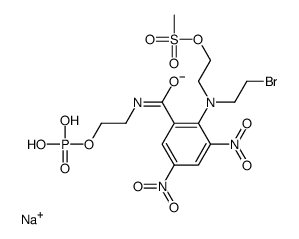| Description |
PR-104 (sodium) is a selective hypoxia-activated DNA cross-linking agent and can be used for the research of multiple tumor xenograft models. PR-104 (sodium), as a nitrogen mustard pre-prodrug, is converted efficiently to the more lipophilic dinitrobenzamide mustards alcohol PR-104A[1].
|
| Related Catalog |
|
| In Vitro |
PR-104 (sodium) (80 μM; 1 hour; SiHa cells) shows greater suppression of radiation-induced DNA single-strand breaks under hypoxic than aerobic conditions. PR-104 (sodium) (100 μM; 1 hour; SiHa cells) results in phosphorylation of Ser139 of histone H2AX (gH2AX). PR-104 (sodium) (0.266 mmol/kg; 18 h; SiHa cells) shows activity against hypoxic cells after irradiation. PR-104 (sodium) varies in potency between cell lines, with the lowest IC50 (0.51 μmol/L) in H460 cells and highest (7.3 μmol/L) in PC3 prostate cells[1].
|
| In Vivo |
PR-104 (sodium) (0.56 mmol/kg; i.v. or i.p.; 0~2 hours) makes the plasma area under the curve. PR-104 (sodium) (0.23 mmol/kg; i.p.; 100 days) shows antitumor activity[1]. Animal Model: CD-1nu/nu mice Dosage: 0.56 mmol/kg (Pharmacokinetics Analysis) Administration: I.v. or i.p. Result: The plasma area under the curve. Animal Model: CD1-Foxn1nu mice Dosage: 0.23 mmol/kg Administration: I.p. Result: Showed antitumor activity.
|
| References |
[1]. Patterson AV, et al. Mechanism of action and preclinical antitumor activity of the novel hypoxia-activated DNA cross-linking agent PR-104. Clin Cancer Res. 2007;13(13):3922-3932.
|
